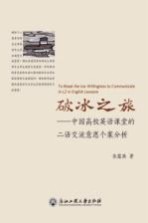

破冰之旅 中国高校英语课堂的二语交流意愿个案分析PDF格式文档图书下载
- 购买点数:11 点
- 作 者:张露茜著
- 出 版 社:杭州:浙江工商大学出版社
- 出版年份:2016
- ISBN:9787517814771
- 标注页数:274 页
- PDF页数:299 页
Chapter 1 Introduction 1
1.1 Research problem 1
1.2 Research motive 3
1.3 Research aim and questions 4
1.4 Significance of the study 5
1.5 Outline of this book 6
Chapter 2 Chinese Context 8
2.1 English in China 8
2.1.1 Definitions of China English 13
2.1.2 The impacts of dialects and Putonghua on English 14
2.2 College English 17
2.3 Willingness to communicate(WTC) 19
2.4 Conclusion 22
Chapter 3 Literature Review 23
3.1 Establishment of WTC in L1 24
3.2 Estahlishment of WTC in L2 28
3.3 Development of L2 WTC studies and theories 31
3.3.1 Recent L2 WTC studies outside China 35
3.3.2 Recent L2 WTC studies in China 43
3.4 The Chinese WTC model 52
3.4.1 Factors in the Chinese WTC model 52
3.4.2 Challenged collectivistic outlook of the Chinese 63
3.5 Conclusion 64
Chapter 4 Methodology 66
4.1 Research design 66
4.2 The case study approach 70
4.3 Research setting and participants 72
4.4 Instruments 74
4.4.1 Questionnaires 74
4.4.2 Documents 78
4.4.3 Student narratives 81
4.4.4 Classroom observations 82
4.4.5 Stimulated recalls 84
4.4.6 Semi-structured interviews 85
4.5 Data analysis procedures 88
4.6 Ethical issues 91
Chapter 5 Pilot Studies 93
5.1 Pilot Study One 93
5.2 Pilot Study Two 95
5.2.1 Data screen 95
5.2.2 Exploratory factor analysis(EFA) 97
Chapter 6 Study One 105
6.1 Data screen 105
6.2 Findings 107
6.2.1 Confirmatory factor analysis(CFA) 108
6.2.2 Multi-group confirmatory factor analysis(MGCFA) 112
6.2.3 Structural equation modeling(SEM) 118
6.2.4 Multi-group structural equation modeling(MGSEM) 123
6.3 Discussion 130
6.3.1 Research Questions One—personal factors that facilitate or hinder BE students'WTC,and Three—interactions between personal and contextual factors 133
6.3.2 Research Question Four—pedagogical changes 138
6.4 Conclusion 140
Chapter 7 Study Two 142
7.1 Participant information in qualitative studies 142
7.2 Document analysis outcomes 144
7.3 Classroom observation findings 147
7.4 Teacher interview results 155
7.4.1 Teacher with weak classroom context 157
7.4.2 Teacher with supportive classroom context 160
7.5 Discussion 163
7.5.1 Research Question Two—contextual factors that facilitate or hinder BE students'WTC 163
7.5.2 Research Question Three—interactions between personal and contextual factors 167
7.5.3 Research Question Four—pedagogical changes 168
Chapter 8 Study Three 172
8.1 Student narratives 172
8.1.1 High WTC and weak context 174
8.1.2 High WTC and supportive context 176
8.1.3 Low WTC and weak context 178
8.1.4 Low WTC and supportive context 180
8.2 Stimulated recalls 182
8.3 Student interviews 184
8.3.1 Societal context 186
8.3.2 Personality 188
8.3.3 Motivation 189
8.3.4 Attitudes 192
8.4 Discussion 193
8.4.1 Research Question One—personal factors that facilitate or hinder BE students'WTC 194
8.4.2 Research Question Three—interactions between personal and contextual factors 197
8.4.3 Research Question Four—pedagogical changes 199
Chapter 9 Discussion 203
9.1 Combining findings 203
9.1.1 A three-dimension Chinese L2 WTC model 203
9.1.2 Data combining outcomes 206
9.2 Relating findings with previous L2 WTC studies 208
9.3 Lack of teacher support 210
Chapter 10 Conclusions 213
10.1 Research mission of the study 213
10.2 Summary of findings 215
10.2.1 Research Question One-personal factors that facilitate or hinder BE students'WTC 216
10.2.2 Research Question Two—contextual factors that facilitate or hinder BE students'WTC 218
10.2.3 Research Question Three—interactions between personal and contextual factors 220
10.2.4 Research Question Four—pedagogical changes 221
10.3 Limitations and future research 224
10.4 Conclusion 225
References 227
Appendix A WTC Questionnaires in Spoken English in English Language Classrooms 257
Appendix B Classroom Observation Sheet 265
Appendix C Stimulated Recall Questions 266
Appendix D Interview Questions with BE Students 267
Appendix E Interview Questions with English Teachers 270
Appendix F Thematic Coding of Qualitative Data 271
Appendix G A Sample Student Narrative 272
- 《破冰之旅 中国高校英语课堂的二语交流意愿个案分析》张露茜著 2016
- 《破冰之旅 中国高校英语课堂的二语交流意愿个案分析》张露茜著 2015
- 《高效课堂“破冰”之旅 小学“361”快乐课堂实施的途径与方法》蔡祖泉主编 2012
- 《课堂教学的颠覆与重建 山东省乐陵市第一实验小学“大语文教育”的破冰之旅》陶继新,李升勇著 2010
- 《破冰之旅》张胜友著 2005
- 《北纬90度-破冰之旅》刘远著 2010
- 《破冰之旅 上》王文才著 2010
- 《破冰之旅 下》王文才著 2010
- 《破冰之旅 科技资源开放共享的“北京模式”》北京市科学技术委员会编著 2012
- 《破冰之旅 北海市处置停缓建工程实录》李延强主编;文泉源,陈希光,邹文副主编 2006
- 《山里的猴子》(英)露茜·丹尼尔斯(Lucy Daniels)著;曹苏玲译 2002
- 《中央研究院近代史研究所目录汇编 5 近代中国妇女史中文资料目录》王树槐,成露茜,吕芳上,曼素恩,张瑞德,游鉴明,鲍家麟主编;王哲圣,宿金玺,张凯达,萧惠心助编 1995
- 《破冰之旅 中国高校英语课堂的二语交流意愿个案分析》张露茜著 2016
- 《破冰之旅 中国高校英语课堂的二语交流意愿个案分析》张露茜著 2015
- 《青春私语 女生200问》(德)加比·舒施特著;(德)露茜·凯泽插图;顾文捷,田庆译 2006
- 《小考拉比尔》(澳)沃尔著;程璐,董露茜译 2007
- 《IQ家教启蒙 如何开发孩子的学习潜能》(美)露茜·卡尔金斯(Lucy Calkins)著;胡翠君等译 1998
- 《中央研究院近代史研究所目录汇编 4 海内外图书馆收藏有关妇女研究中文期刊联合目录》王树槐,成露茜,吕芳上,曼素恩,张瑞德,游鉴明,鲍家麟主编;王哲圣,宿金玺,张凯达,萧惠心助编 1995
- 《门廊里的小马》(英)露茜·丹尼尔斯(Lucy Daniels)著;蔡文译 2002
- 《批判的媒体识读》成露茜,罗晓南主编=Critical media literacy 2222
- 《应用型人才培养理论与实践 浙江工商大学杭州商学院2009年论文集》张俊英主编 2009
- 《人才培养与教学改革 浙江工商大学教学改革论文集 2011》陈寿灿编 2012
- 《说杭州 下》王国平总主编;钟毓龙编著;钟肇恒增补 2016
- 《浙江工商大学法律评论》孔庆江主编 2005
- 《浙江省“2+2”考试辅导教材高等数学宝典》金义明主编 2011
- 《浙江工商大学志 1911-2011》《浙江工商大学志》编纂委员会编 2011
- 《法治思维品质检察 来自浙江杭州的探索》杭州市人民检察院编 2015
- 《青年教授零距离 浙江工商大学青年教授风采录》浙江工商大学青年教授联谊会主编 2012
- 《戏文概论 谜史》钱南扬编著 2009
- 《浙江工商大学统计学文集 1 统计拾贝》李金昌主编;洪兴建副主编 2014
